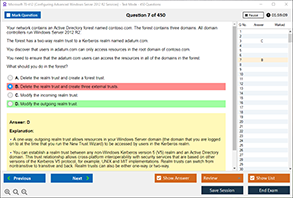Overview of CompTIA Network+ (N10-008) Exam
The CompTIA Network+ (N10-008) certification is a foundational credential for IT professionals who wish to pursue careers in network administration, support, and security. As a globally recognized certification, it validates the essential skills needed to design, configure, manage, and troubleshoot wired and wireless networks. The N10-008 exam emphasizes current networking technologies, cloud computing practices, virtual networking, and security protocols. With the growing demand for skilled network professionals, obtaining the Network+ certification is an essential step in establishing credibility and advancing in the IT field.
DumpsBoss provides top-tier resources for candidates preparing for the N10-008 exam, including up-to-date practice questions, exam dumps, and insightful explanations that mirror the structure and complexity of the actual exam. DumpsBoss's expertly curated materials help test-takers understand key concepts thoroughly, increasing their chances of passing the exam on the first attempt.
Types of Network Connections
Networking connections can be broadly categorized into two main types: physical (wired) and wireless. Each type plays a critical role in how data is transmitted and received within and across networks. Understanding the characteristics, benefits, and limitations of these connections is crucial for the N10-008 exam.
-
Wired Connections: These include Ethernet cables (Cat5e, Cat6, etc.), coaxial cables, and fiber-optic cables. Wired connections are known for their speed, reliability, and security.
-
Wireless Connections: These include Wi-Fi, Bluetooth, NFC, and cellular data networks. Wireless technologies are convenient and widely used in mobile and home networks but may suffer from interference and security vulnerabilities.
The N10-008 exam assesses a candidate's ability to differentiate between these types, understand their implementation, and troubleshoot issues effectively.
Physical Network Connections (Focus Area)
Physical or wired network connections form the backbone of modern networking infrastructure. These connections provide a stable and secure medium for data transmission and are prevalent in enterprise environments.
-
Ethernet (Twisted Pair):
-
The most common type of wired network connection.
-
Uses Cat5e, Cat6, and Cat6a cables for data transmission.
-
Capable of supporting speeds from 100 Mbps up to 10 Gbps or more.
-
Includes standards such as 10BASE-T, 100BASE-TX, and 1000BASE-T.
-
-
Fiber Optic Cables:
-
Utilize light to transmit data over long distances with minimal signal loss.
-
Two types: Single-mode (long-distance) and multi-mode (short-distance).
-
Immune to electromagnetic interference (EMI) and capable of ultra-high speeds.
-
-
Coaxial Cables:
-
Used historically in older networks and still found in cable internet services.
-
Comprised of a central conductor, insulating layer, and shielding.
-
-
Serial and Parallel Cables:
-
Used in legacy systems.
-
Primarily for device-to-device communication (e.g., between routers or switches).
-
Physical connections are crucial for understanding network topologies, cabling standards, and media types—all key areas tested on the Network+ exam.
Other Relevant Components
In addition to cable types, several other physical components are relevant to the N10-008 exam:
-
Connectors and Interfaces:
-
RJ-45: Commonly used with Ethernet cables.
-
LC, SC, ST: Used with fiber optic cables.
-
BNC: Often found in coaxial cable setups.
-
-
Patch Panels and Switches:
-
Patch panels organize and route physical cables in a network.
-
Switches manage traffic on wired networks and are essential for LAN performance.
-
-
Media Converters:
-
Allow for conversion between different media types, such as fiber to Ethernet.
-
-
Transceivers (GBIC, SFP, QSFP):
-
Plug-in modules used in network switches and routers to support fiber optic and copper connections.
-
A solid grasp of these physical components and their roles in network setups is essential to performing well on the exam.
Comparison with Wireless Connections
While wired connections provide speed and security, wireless networks offer flexibility and mobility. The exam often tests candidates' understanding of the trade-offs between the two:
| Feature | Wired Connection | Wireless Connection |
|---|---|---|
| Speed | Typically faster (up to 100 Gbps) | Slower due to signal interference |
| Security | More secure, difficult to intercept | More vulnerable to attacks |
| Installation | Requires cabling and planning | Easier to deploy, especially in open areas |
| Mobility | Limited | High mobility for users and devices |
| Interference | Minimal | Susceptible to EMI, weather, and physical obstructions |
Understanding these differences allows test-takers to choose appropriate solutions for various networking scenarios, a skill that DumpsBoss helps reinforce through practical questions and study materials.
Common Exam Pitfalls & Misconceptions
Many candidates approach the Network+ exam with incomplete or outdated knowledge, leading to common pitfalls:
-
Confusing Cable Categories:
-
Assuming Cat5e and Cat6 are interchangeable without understanding bandwidth differences.
-
-
Misidentifying Fiber Types:
-
Confusing single-mode and multi-mode fiber based on connector types instead of core diameter and application.
-
-
Underestimating Legacy Technologies:
-
Ignoring coaxial and serial cables, which may still appear on the exam.
-
-
Overlooking Physical Layer Components:
-
Focusing solely on software and protocol layers while neglecting cables, connectors, and interface types.
-
-
Relying on Outdated Study Materials:
-
Studying from outdated resources that don't reflect the N10-008 objectives.
-
DumpsBoss mitigates these risks by providing current, accurate, and exam-aligned materials. Their practice exams are structured to reflect the actual test format and commonly tested concepts, helping candidates identify and correct misconceptions before exam day.
Conclusion
Mastering physical network connections is critical for anyone aiming to pass the CompTIA Network+ (N10-008) exam. From understanding Ethernet and fiber optic cabling to recognizing connectors and configuring switches, these foundational skills form the core of efficient network design and troubleshooting.
DumpsBoss stands out as a premier exam preparation resource, offering candidates access to expertly crafted dumps, practice tests, and comprehensive guides tailored to the latest Network+ exam objectives. By utilizing DumpsBoss, learners can bridge knowledge gaps, avoid common pitfalls, and approach the N10-008 exam with confidence.
Investing time in mastering the physical aspects of networking not only ensures success in certification but also lays the groundwork for a strong and enduring career in IT networking. With DumpsBoss by your side, your path to Network+ certification becomes more accessible and achievable.
Special Discount: Offer Valid For Limited Time “CompTIA N10-008 Dumps” Order Now!
Sample Questions for CompTIA N10-008 Exam Dumps
Actual exam question from CompTIA N10-008 Exam.
Which connection physically connects the end device to the network?
A) Wireless Access Point
B) VPN Connection
C) Network Interface Card (NIC)
D) Firewall



